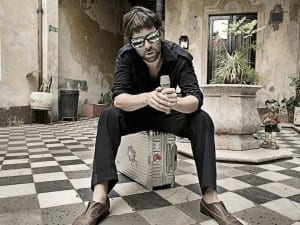Review by Regina Papachlimitzou
Unon entering What Next For The Body, you are greeted by a warm and comfy lounge, complete with inviting brocade sofa and armchairs, a table littered with art books, and low lighting. The gallery is inviting you to take some time to relax, make use of the reading material provided, leave an opinion or just contemplate the exhibition on your way out. This feeling is quite unlike what you might be used to experiencing upon entering the high-ceilinged, almost austere foyer of Arnolfini.
It doesn’t last long. In stark contrast to the cosy familiarity inspired by the little lounge (which could have easily belonged to a friend or neighbour), the first set of artworks looming around the corner plunge the visitor into the unfamiliar, disconcerting environment of what appears to be a biological laboratory. Leaving the lounge behind, you find yourself confronted by Kira O’Reilly and Jennifer Willet’s work Refolding (Laboratory Architectures). The first picture, mounted on the gallery wall, is of a cluttered lab populated with specimens that appear to be loosely following the evolution of life: preserved in jars we can spot seaweed, simple fish, crustaceans, and more complicated fish. There are also skeletons of a bird and two hominids, lonely remnants of once living organisms now reduced to mere science class specimens. In the centre of the lab stands a chest freezer, the lid open to reveal a contorting mass covered in white lab coats; two legs (belonging, presumably, to different individuals) stick awkwardly out from underneath the fabric. No clue or explanation is given as to the origin of these body members: only a lingering sense of the messiness of human life juxtaposed with the meticulousness of the specimens preserved in the lab for study.
A few steps away stands the very freezer featuring in the centre of the previous picture, and peering in it you realise another picture awaits you. It is possibly the same lab, albeit cleared out of everything that isn’t a permanent lab fixture; the sole exception being the freezer that featured in the first artwork, the freezer you yourself are now standing in front of. A mysterious figure is climbing into or possibly out of it: only a leg is visible, a faint “x” carved mid-calf, the foot tensed against the hard surface of the dimly reflecting floor. The rest of the figure is covered by lab coats thrown on in disarray, in a manner that makes them appear like a dishevelled shroud, one which gives little indication as to the outline of the figure beneath it. A similar contortion of the human figure as in the previous artwork is present, only in this work the stark sterility of the surroundings, bare of any other intimation of life, render the solitary figure at once more poignant and more enigmatic. The figure’s position in front of the cooling box mirrors that of the visitor contemplating the artwork; a subtle way of pulling you into the artwork’s unsettling world, of inviting you to question your own position in space, inside your own body.
On the second floor of the exhibition are installed Teresa Margolles’s arresting pieces, 37 Cuerpos (37 Bodies) and Aire (Air). The first work consists of threads once used after an autopsy, to sew up bodies of people who met with violent deaths. The string of threads stretches across the largest gallery of the Arnolfini; the threads themselves are stained dark red or brown, presumably as a result of the various processes followed in the morgue. By confronting us with the physical dregs of post-mortem examination, Margolles denies us the distance we usually enjoy between our own selves and violent death. On a more fundamental level, the artist brings to the fore our discomfort in the face of death: not necessarily the tragedy or senselessness of it, but simply the physical fact of death and how uncomfortable we are with it, how much we have banished its physical reality from our daily experience and from our thoughts.
Tight plastic flaps hang heavily over the entrance of the adjacent room, where Margolles’s second piece, Aire, is installed; the work itself consists of two cooling systems humidifying the air in the otherwise empty room with water previously used to wash bodies before autopsy. A note below the description of the work informs the visitor that “The water used in this installation is completely safe” -a practical consideration, which serves as a poignant reminder of art’s role as a mediator between an individual and tragedy, of its rendering tragedy suitable (digestible almost) as an object of contemplation. It would be fair to suggest that, on some level, experiencing this artwork is almost a non-event –the same way that, often, other people’s deaths can be a non-event, be it due to geographical or social distance, the distance afforded to a medical professional, ignorance, or simply a lack of interest. In this sense, Margolles’s work is at once an honest expression of one of the ways in which we can react to violent deaths that don’t impact on us directly, and an invitation to consider our own (lack of) reaction to other people’s suffering and loss.
In addition to Richard Hancock and Traci Kelly’s haunting work Untitled (After Iconographia), the gallery hosts works by Zoran Todorovic, Jordan McKenzie, and Back to Back Theatre, exploring the themes of corporeality, absence, and their relation to the self.
What Next For The Body continues until Sunday 6 February 2011 at Arnolfini in Bristol. www. arnolfini.org.uk
The exhbition is part of the Inbetween Time Festival of Live Art and Intrigue , which takes place across the streets, sites and art spaces of Bristol. Over 75 events involving 130 artists from the UK and beyond will make up a breakneck programme of live, digital, sound, sculptural, architectural, dance, theatre and guerrilla works. www.inbetweentime.co.uk
Read a Q&A from Issue 34 (Apr/May 2010) with Tom Trevor, Director of Arnolfini.
Image © Kira O’Reilly & Jennifer Willet





